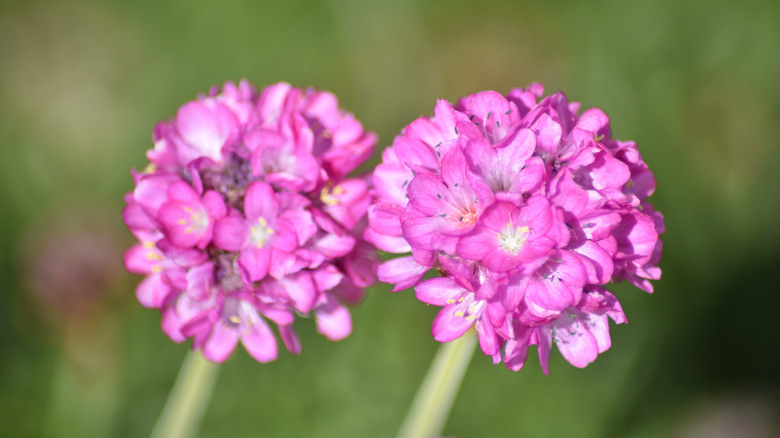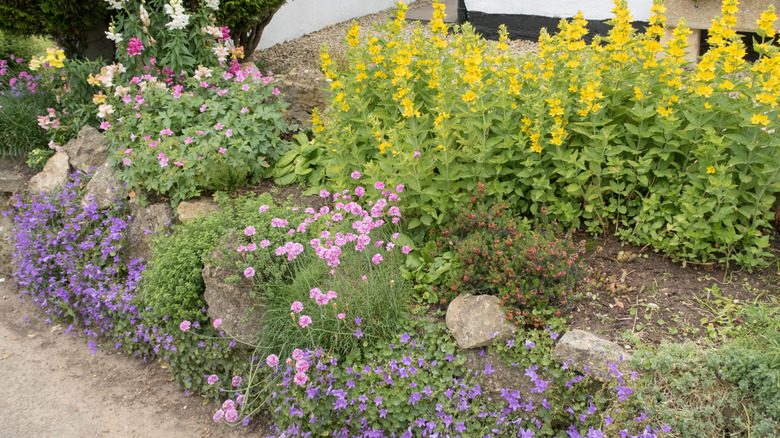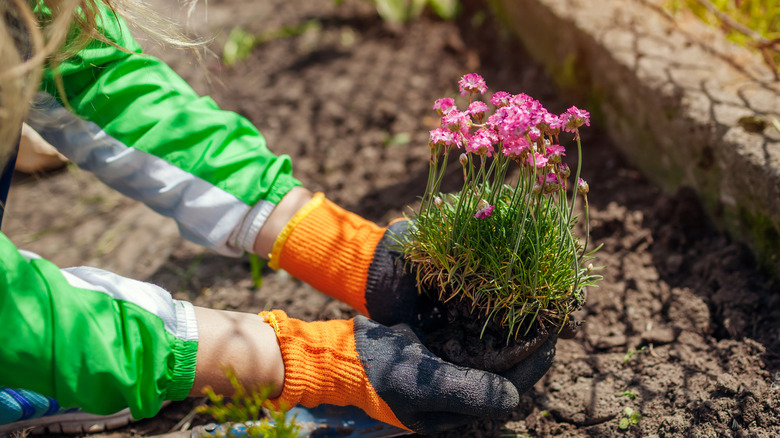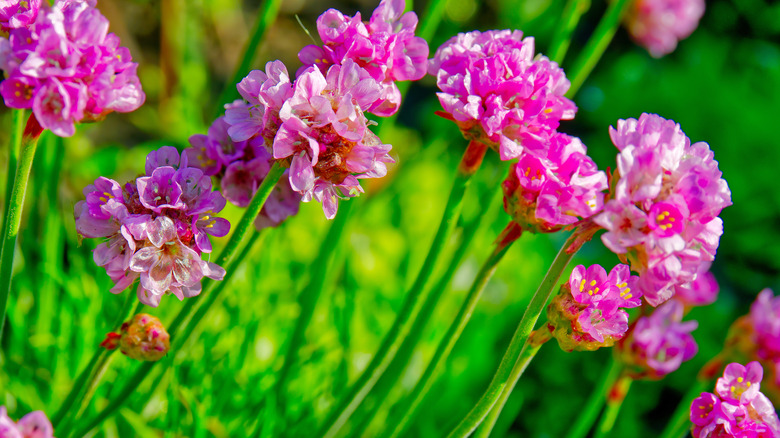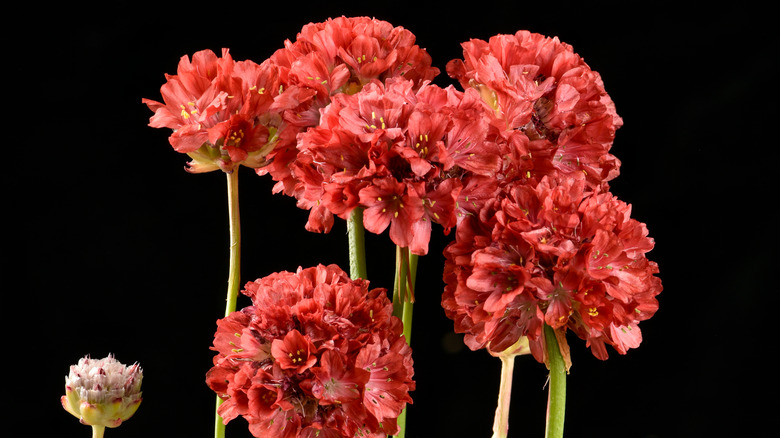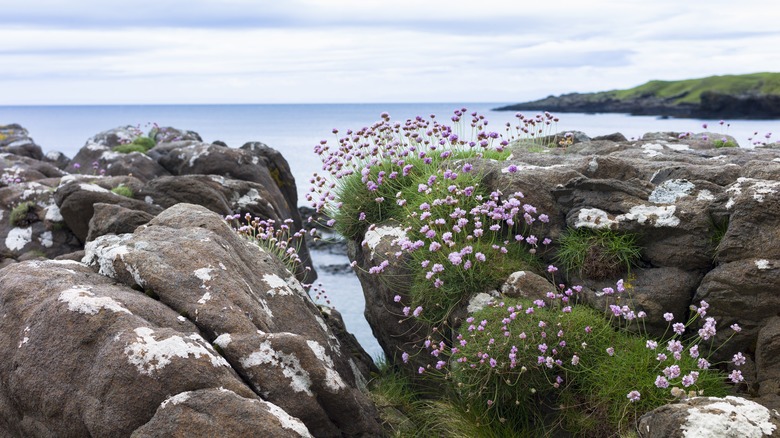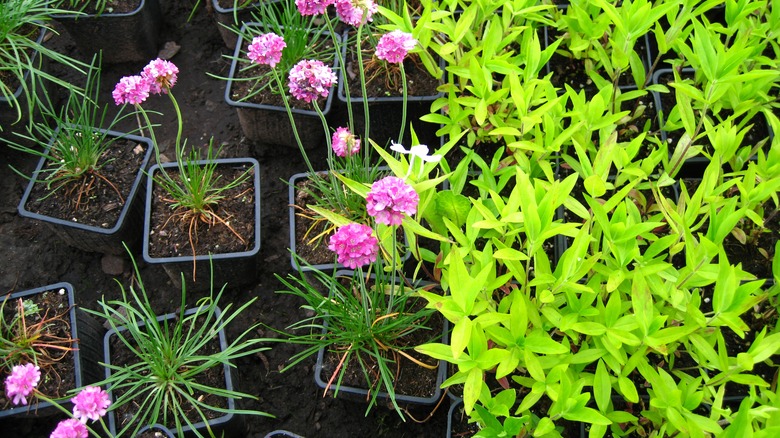Sea Thrift: Everything You Should Know Before Planting
For a mid-spring pop of pink in the garden, you can't go wrong with Armeria maritima. Commonly called sea thrift, these flowers bloom in clusters that explode like pompoms at the end of leafless stalks called scapes. They reach for the sun, up and away from the plant's deep green foliage, which is often compared to blades of grass. The foliage spreads to form a thick, low mound making this a great choice as a ground cover plant.
Per the NC State Extension Gardener Toolbox, the sea thrift can be found all over Europe and North America, including Greenland. Due to its non-woody stems and penchant for coming back again each year, Armeria maritima is considered an herbaceous perennial. Hardy Plants UK explains that this means the roots survive underground after the rest of it dies back for the winter. The following spring you can expect a new crop of scapes and flower heads.
Topping out at a mere 12 inches tall, this peppy little flower can survive in rather uninviting and infertile landscapes. In fact, it prefers rocks and sandy soil as it lives its perfectly happy life along the perilous edges of windy sea cliffs. NC State lists a slew of nicknames the sea thrift has collected over the years, including ladies pincushion, cliff rose, sea gilliflower, and marsh daisy, to name but a few. For folks in the UK and Ireland, where they are found along nearly every inch of coastline, they're mostly known as sea pinks.
How to use sea thrift in a garden
According to the Plant of the Week series published by The Guardian, sea pinks (as the Brits call them) love the coast, hence references to the sea in both of the plant's common names. They require complete drainage and fare quite well when planted among rocks. So, sea thrift is a perfect addition to a rock garden or wall provided you live within USDA hardiness zones 4 through 8. It will also work in landscapes with high sun and low-quality soil or gravel.
The Guardian suggests pairing sea thrift with other plants that can handle a high level of drought, but considering its flush of pink or white flower clusters, it will also look fantastic among other brightly colored blooms. Pictured above, you can see its delightful splash of pink meshes nicely alongside yellows and purples. To bring an array of color to your garden, Petitti Garden Center recommends companion plants such as candy tuft, daylilies, and columbine.
Another way to put your thrifts to work is to use them as border plants. Give them a front-row seat since they're somewhat on the small side. They'll look great mixed into containers too. Finally, Petitti Garden Center tosses out the fun idea of surrounding your mailbox post with some sweet shades of pink. What a way to welcome visitors as they arrive at your home!
How to grow sea thrift
In the middle of summer, you can propagate sea thrift through cuttings. Earlier or later in the year, you'll want to do it by root division. Get Gardening shows a very simple method on their YouTube channel, which is best done at the end of summer before fall arrives. At this point in the year, your Armeria will have finished blooming, leaving only the grassy foliage mound. Gently fold back the leaves to reveal the roots of the plants. They will look like they're all clumped together but each root represents a single plant. Pick one and dig your finger down into the soil so you can break it off as far down as possible. Once this piece is broken off, you should see some small feeder roots emerging from the main root. Move this new plant to wherever you would like it to grow.
Funny as it may sound, this is one of those rare plants that will not grow well in your typically rich and fertile potting soil. Remember that in the wild, they're found on rocky cliffs, so you should plant accordingly. A small hole will be plenty for you to push the roots into. Tamp it down so it finds a secure holding and water lightly. New plants will need a bit of extra water for their first few weeks, but as always with sea thrift, be careful not to overdo it or else you run the risk of perpetuating root rot.
How to care for sea thrift
Sea thrifts cannot handle any level of moisture retention in their soil. The horticultural extension at University of Wisconsin-Madison says it will cause them to rot from the center of their foliage mound and eventually die off completely. This is why thorough drainage is so vital. Once you've found your thrifts a sunny, sandy home close to some rocks in your garden or landscape, it's time to move into maintenance and care mode. This is definitely a plant you want to deadhead. But instead of just removing the spent blossoms, break off the entire scape from the base. This is the best way to encourage a second round of blossoms later in the season.
Sea thrift plants are evergreen, meaning the leaves will remain flush and green year-round. For this reason, University of Wisconsin-Madison does not recommend cutting it back when it gets colder like you probably will with some of your other planted perennials.
Sea thrift varieties
The practice of breeding hybrids has brought many varieties of Armeria maritima to market, each with different colored flowers and slightly varying sizes. Generally speaking, they will all look similar in form and thrive under the same environmental conditions. Here are some interesting cultivars worth checking out:
- Armeria 'alba' — This variety bears delicate white flower clusters at a height of around 6 inches.
- Armeria 'Dusseldorf Pride' — As a dwarf variety with vivid fuchsia blooms, Dusseldorf Pride will stay rather compact.
- Armeria 'Splendens' — Splendens grow taller and veer toward a more reddish hue.
- Armeria 'Vindictive' — With even redder blossoms, perhaps this one got its name from the anger and passion sometimes associated with the color. Per Garden Beast, the Vindictive cultivar received the coveted Award of Garden Merit from the Royal Horticultural Society.
- Armeria caespitosa 'Deep Form' — Recommended as a super cute option in a lovely shade of pale pink, it lies very low to the ground with its scapes only reaching a maximum height of 5 inches.
- Armeria 'Twin' — The Twin is a thrift with a twist. It is known as a bi-color variety because it produces both white and pink flower clusters on the same plant.
- Armeria pseudarmeria 'Ballerina Red' — If you're looking for the truest red in the bunch, then Ballerina Red (pictured above) is the way to go.
Is sea thrift toxic?
Overconsumption of the stems, leaves, or flowers of any plant carries the risk of making an animal feel temporarily unwell, especially in regard to gastrointestinal issues. However, Armeria maritima sea thrift plants are not considered to be poisonous, which means that even if your dog or cat goes a little too far with the sampling, they will not develop any serious symptoms or conditions. Since they are not included on either the ASPCA or the Humane Society's lists of toxic plants, you can feel comfortable adding a colorful wave of sea thrifts to your yard without worrying about harming your pets.
Plants for a Future reports that this plant is known to have antibiotic properties when ingested by humans, yet it may cause irritation to the skin when applied externally. A dried version of the plant may help curb obesity and aid in relief from nervous disorders. More scientific study on the matter would need to be completed before these uses could be confirmed.
How to repot sea thrift
When your sea thrift plants come home with you from the garden center in their little grow pots, they'll most likely be ready for a new home. Check for any roots peeping out of the bottom holes and you'll be extra sure. If you're transplanting them into the garden, you'll be good to go with just a trowel and a pair of garden gloves. If you choose to repot them into larger containers, there are a few more considerations to make. First up is container choice. With the sea thrift, drainage holes will be mandatory. Nature and Garden offers a great tip for improving drainage one step further. Before filling your new pot with soil, fill the bottom of it with small rocks or clay pebbles. This will increase airflow as well.
When you have your pot situated, be sure to use a plant-appropriate potting mix. For your Armeria, that's going to be a soil mixture that leans towards the acidic side of the pH scale. Secure the base of the plant where it meets the soil with one hand and gently tip your grow pot over. Tap on the bottom with your other hand and you should be able to easily remove the young plant. Place it into the new pot and backfill any empty space with more soil and even a few more pebbles. Gently water and it should be good to go.
